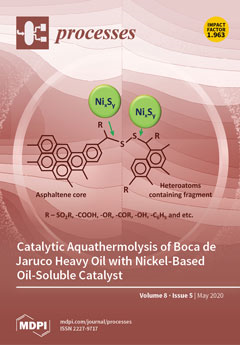The effect of blanching conditions on the hot-air drying kinetics of three pomegranates (cvs. “Acco”, “Herskawitz” and “Wonderful”) were assessed. Water blanching conditions considered were 90 °C for 30 s, 90 °C for 60 s, 100 °C for 30 s and 100 °C
[...] Read more.
The effect of blanching conditions on the hot-air drying kinetics of three pomegranates (cvs. “Acco”, “Herskawitz” and “Wonderful”) were assessed. Water blanching conditions considered were 90 °C for 30 s, 90 °C for 60 s, 100 °C for 30 s and 100 °C for 60 s. The drying experiments were carried out at 60 °C, 19.6% relative humidity and at a constant air velocity of 1.0 m s
−1. The experimental curves were fitted to seven different drying models. For the Acco cultivar, the drying behaviour was best predicted by the Logarithmic and Page model for blanched (R
2 ranging between 0.9966 and 0.9989) and unblanched (R
2 = 0.9918) samples, respectively. Furthermore, for the Herskawitz cultivar, Logarithm, Page and Midili models were most suitable for predicting drying behaviour of both blanched and unblanched samples. Also, for the Wonderful cultivar, Logarithm and Midili models were most accurate for predicting the drying behaviour for both blanched and unblanched samples amongst other models. The blanched samples dried faster with shorter drying times: “Acco” (7 h), “Herskawitz” (8 h), and “Wonderful” (7 h), compared to the unblanched samples, which dried after 15, 20 and 11 h, respectively. Effective diffusion coefficient of moisture in pomegranate arils ranged from 4.81 × 10
−9 and 1.11 × 10
−8 m
2 s
−1 for the Acco cultivar, for the Herskawitz cultivar; 3.29 × 10
−9 and 1.01 × 10
−8 m
2 s
−1 and for the Wonderful cultivar; 5.83 × 10
−9 and 1.09 × 10
−8 m
2 s
−1. Overall, blanching resulted in low energy consumption during drying of pomegranate arils. In addition, the Logarithmic model generally showed an appropriate model for blanched samples regardless of cultivar. For unblanched samples, the Page model was more appropriate for “Acco” and “Herskawitz”, while the Midili model was appropriate for “Wonderful”. Therefore, this study provided science-based and practical drying conditions for the investigated pomegranate cultivars.
Full article





